
How Everyday Toxins Undermine Your Health and What You Can Do About It
Table of Contents
Modern life puts us in contact with hundreds of hidden chemicals every single day. They're in the water we drink, the air we breathe, the products we use, and even the furniture we sit on. While some of these substances are considered safe in small amounts, others quietly accumulate in our bodies over time, contributing to a host of chronic health problems, from hormone disruption to fatigue and immune dysfunction.
Here we’ll unpack the subtle but powerful impact environmental toxins have on our well-being and more importantly, what you can do today to create a safer, healthier home.
1. Hormonal Chaos: When Chemicals Hijack Your Endocrine System
Many everyday products, from plastic containers and food wraps to shampoo and air fresheners, contain endocrine-disrupting chemicals (EDCs) such as BPA, phthalates, and parabens. These substances mimic or interfere with the body’s natural hormones, which can affect:
- Metabolism and weight balance
- Fertility and reproductive health
- Thyroid function
- Mood and energy levels
2. Toxins and the Immune System: A Constant Battle
Our immune system is designed to defend against viruses, bacteria, and environmental threats. But when our bodies are burdened with accumulated toxins, our detox organs, especially the liver, kidneys, and lymphatic system, can’t keep up.
- Over time, this toxic burden may:
- Increase systemic inflammation
- Lower your defences during cold & flu season
- Exacerbate chronic illnesses
- Make daily life feel more exhausting
This is especially critical for kids, whose immune systems are still developing and who breathe more air and drink more water per pound of body weight than adults.
3. Indoor Air Quality: The Invisible Threat
Believe it or not, indoor air pollution can be two to five times worse than outdoor air, according to the EPA. Common culprits include:
- Volatile Organic Compounds (VOCs) from cleaners, paints, and furniture
- Mold spores and dust
- Synthetic air fresheners and fragrances
These toxins can trigger allergies, asthma, headaches, and even long-term respiratory issues. If you’ve ever felt dizzy, tired, or “foggy” after using conventional cleaning sprays or being in a freshly painted room, this is why.
4. Cognitive Health: Brain Fog Isn’t Just in Your Head
Emerging research shows that environmental toxins don’t just affect the body; they can also impact the brain. Long-term exposure to air pollution and chemical-laden environments has been linked to:
- Decreased cognitive performance
- Increased risk of Alzheimer’s disease and Parkinson’s
- More frequent “brain fog” or difficulty concentrating
5. Silent Saboteurs: Carcinogens & Long-Term Health Risks
While we often hear about formaldehyde or asbestos in extreme cases, low-level exposure to carcinogenic chemicals in our homes can quietly undermine long-term health. These include:
- Formaldehyde in pressed wood products
- PFAS (“forever chemicals”) in stain-resistant fabrics and nonstick cookware
- Heavy metals like lead and mercury in water or imported goods
Over time, these compounds can increase cancer risks and damage the liver, kidneys, and nervous system.
6. Digestive & Reproductive Disruption: More Than Just Bloating
Toxin exposure can wreak havoc on your gut microbiome, leading to:
- Bloating and indigestion
- Food sensitivities
- Weakened nutrient absorption
At the same time, many of these same toxins, especially solvents, pesticides, and phthalates,can negatively affect reproductive health, harming fertility, pregnancy outcomes, and even the long-term development of children.
What You Can Do: Simple, Powerful Ways to Lower Your Toxic Load
Thankfully, you don’t need a hazmat suit or a total home renovation to reduce your exposure.
Small, consistent changes can make a major impact!
1. Choose Safer Cleaning Products
Ditch the bleach, ammonia, and chemical-heavy sprays in favor of non-toxic, probiotic-based cleaners like Hyve Probiotic cleaners work differently. They restore healthy bacteria to surfaces, helping break down grime naturally and continue cleaning long after you’ve sprayed. They’re:
- Safe for kids and pets
- Free of harmful VOCs and fumes
- Gentle on skin but tough on dirt
2. Improve Ventilation
- Open windows during and after cleaning
- Use HEPA filters or air purifiers in common areas
- Add air-purifying plants like spider plants, peace lilies, or pothos
Fresh air and proper circulation can significantly reduce the buildup of indoor toxins and allergens.
3. Minimize Plastic Exposure
Reduce your exposure to plastics and their associated chemicals by switching to:
- Glass or stainless-steel containers
- Silicone or bamboo utensils
- Beeswax wraps instead of plastic wrap
Avoid heating food in plastic containers, which can release harmful compounds into your meals.
A Cleaner Home, A Stronger You
Reducing environmental toxins isn’t about fear, it’s about intentional living. It’s about asking, “What am I bringing into my home? What touches my kids’ skin every day? What’s in the air we breathe?”
The good news is you don’t have to overhaul your life overnight. Start with a few small swaps: safer cleaners, better air flow, fewer plastics and let those changes ripple outward.
At Hyve, our mission is to help you create a sanctuary—a home that supports your health rather than challenges it. By reducing your toxic load, you can unlock more energy, better sleep, clearer thinking, and a more resilient immune system.
Let’s build healthier homes and healthier lives—together.






